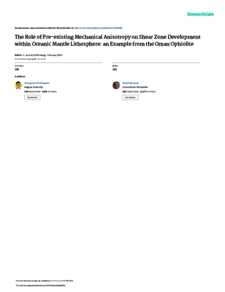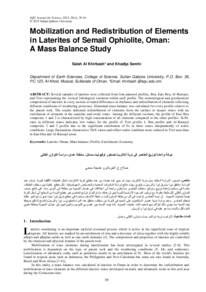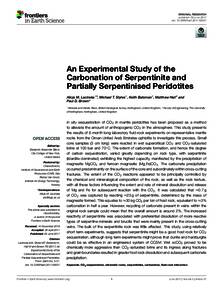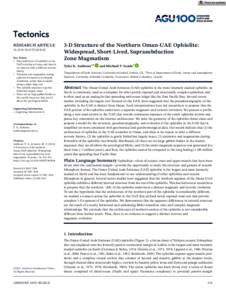Document
The role of pre-existing mechanical anisotropy on shear zone development within oceanic mantle lithosphere : an example from the Oman ophiolite.
Identifier
DOI: 10.1093/petrology/egg099
Source
Journal of Petrology. v. 45, 2, p. 405-414
Contributors
Mainprice, David., Author
Country
United Kingdom.
City
Oxford
Publisher
Oxford University Press
Gregorian
2004-02-01
Language
English
Subject
English abstract
Structural and fabric analysis of the well-exposed Hilti mantle section. Oman ophiolite, suggests that shear zone development, which may have resulted from oceanic plate fragmentation, was influenced by pre-existing mantle fabric present at the paleoridge. Detailed structural mapping in the mantle section revealed a gently undulating structure with an east-west flow direction. A NW-SE strike-slip shear zone cuts across this horizontal structure. The crystal preferred orientation (CPO) of olivine within the foliation is dominated by (010) axial patterns rather than more commonly observed (010) [100] patterns, suggesting that the horizontal flow close to the Moho involved non-coaxial flow. Olivine CPO within the shear zone formed at low temperature is characterized by (001)[100] patterns and a sinistral sense of shear. The olivine CPO becomes weaker with progressive mylonitization and accompanying grain size reduction, and ultimately develops into an ultra-mylonite with a random CPO pattern. The olivine [010]-axis is consistently sub-vertical, even where the horizontal foliation has been rotated to a sub-vertical orientation within the shear zone. These observations suggest that the primary mechanical anisotropy (mantle fabric) has been readily transformed into a secondary structure (shear zone) with minimum modification. This occurred as a result of a change of the olivine slip systems during oceanic detachment and related tectonics during cooling. We propose that primary olivine CPO fabrics may play a significant role in the subsequent structural development of the mantle. Thus, the structural behavior of oceanic mantle. lithosphere during subduction and obduction may be strongly influenced by initial mechanical anisotropy developed at an oceanic spreading center.
ISSN
0022-3530
Category
Journal articles




